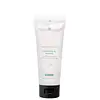What's inside
What's inside
 Key Ingredients
Key Ingredients

 Benefits
Benefits

 Concerns
Concerns

 Ingredients Side-by-side
Ingredients Side-by-side

Water
Skin ConditioningDipropylene Glycol
HumectantGlycerin
HumectantCetyl Ethylhexanoate
EmollientNiacinamide
SmoothingXanthan Gum
EmulsifyingCeratonia Siliqua Gum
EmollientChondrus Crispus
MaskingBetaine
HumectantPanthenol
Skin ConditioningHydroxyacetophenone
AntioxidantEthylhexyl Olivate
Skin ConditioningButyrospermum Parkii Butter
Skin ConditioningPotassium Chloride
Caprylyl Glycol
EmollientButylene Glycol
HumectantCellulose Gum
Emulsion Stabilising1,2-Hexanediol
Skin ConditioningSucrose
HumectantPolyacrylate-13
Sodium Acrylates Copolymer
Algin
MaskingGlyceryl Stearate
EmollientChondrus Crispus Extract
Skin ConditioningGlucomannan
Skin ConditioningPolyglyceryl-4 Oleate
EmulsifyingEthylhexylglycerin
Skin ConditioningHydrolyzed Hyaluronic Acid
HumectantHydrogenated Polyisobutene
EmollientAdenosine
Skin ConditioningPyrus Communis Fruit Extract
Skin ConditioningDisodium EDTA
Polyglyceryl-10 Laurate
Skin ConditioningRosa Damascena Flower Water
MaskingEthylhexyl Palmitate
EmollientAllantoin
Skin ConditioningIris Florentina Root Extract
MaskingSorbitan Isostearate
EmulsifyingCucumis Melo Fruit Extract
Skin ConditioningHydrogenated Lecithin
EmulsifyingHedera Helix Leaf/Stem Extract
AntimicrobialDextrin
AbsorbentCetearyl Alcohol
EmollientStearic Acid
CleansingSodium Hyaluronate
HumectantDipotassium Glycyrrhizate
HumectantCollagen Extract
Skin ConditioningCoriandrum Sativum Extract
Skin ConditioningFoeniculum Vulgare Seed Extract
Skin ConditioningElettaria Cardamomum Seed Extract
PerfumingCrocus Sativus Flower Extract
MaskingHydroxypropyltrimonium Hyaluronate
Ceramide NP
Skin ConditioningTocopherol
AntioxidantCeramide Ns
Skin ConditioningCholesterol
EmollientSodium Acetylated Hyaluronate
HumectantPhytosphingosine
Skin ConditioningCeramide AP
Skin ConditioningCeramide As
Skin ConditioningHyaluronic Acid
HumectantHydrolyzed Sodium Hyaluronate
Skin ConditioningSodium Hyaluronate Crosspolymer
HumectantPotassium Hyaluronate
Skin ConditioningCeramide EOP
Skin ConditioningWater, Dipropylene Glycol, Glycerin, Cetyl Ethylhexanoate, Niacinamide, Xanthan Gum, Ceratonia Siliqua Gum, Chondrus Crispus, Betaine, Panthenol, Hydroxyacetophenone, Ethylhexyl Olivate, Butyrospermum Parkii Butter, Potassium Chloride, Caprylyl Glycol, Butylene Glycol, Cellulose Gum, 1,2-Hexanediol, Sucrose, Polyacrylate-13, Sodium Acrylates Copolymer, Algin, Glyceryl Stearate, Chondrus Crispus Extract, Glucomannan, Polyglyceryl-4 Oleate, Ethylhexylglycerin, Hydrolyzed Hyaluronic Acid, Hydrogenated Polyisobutene, Adenosine, Pyrus Communis Fruit Extract, Disodium EDTA, Polyglyceryl-10 Laurate, Rosa Damascena Flower Water, Ethylhexyl Palmitate, Allantoin, Iris Florentina Root Extract, Sorbitan Isostearate, Cucumis Melo Fruit Extract, Hydrogenated Lecithin, Hedera Helix Leaf/Stem Extract, Dextrin, Cetearyl Alcohol, Stearic Acid, Sodium Hyaluronate, Dipotassium Glycyrrhizate, Collagen Extract, Coriandrum Sativum Extract, Foeniculum Vulgare Seed Extract, Elettaria Cardamomum Seed Extract, Crocus Sativus Flower Extract, Hydroxypropyltrimonium Hyaluronate, Ceramide NP, Tocopherol, Ceramide Ns, Cholesterol, Sodium Acetylated Hyaluronate, Phytosphingosine, Ceramide AP, Ceramide As, Hyaluronic Acid, Hydrolyzed Sodium Hyaluronate, Sodium Hyaluronate Crosspolymer, Potassium Hyaluronate, Ceramide EOP
 Reviews
Reviews

Ingredients Explained
These ingredients are found in both products.
Ingredients higher up in an ingredient list are typically present in a larger amount.
Disodium EDTA plays a role in making products more stable by aiding other preservatives.
It is a chelating agent, meaning it neutralizes metal ions that may be found in a product.
Disodium EDTA is a salt of edetic acid and is found to be safe in cosmetic ingredients.
Learn more about Disodium EDTAGlycerin is already naturally found in your skin. It helps moisturize and protect your skin.
A study from 2016 found glycerin to be more effective as a humectant than AHAs and hyaluronic acid.
As a humectant, it helps the skin stay hydrated by pulling moisture to your skin. The low molecular weight of glycerin allows it to pull moisture into the deeper layers of your skin.
Hydrated skin improves your skin barrier; Your skin barrier helps protect against irritants and bacteria.
Glycerin has also been found to have antimicrobial and antiviral properties. Due to these properties, glycerin is often used in wound and burn treatments.
In cosmetics, glycerin is usually derived from plants such as soybean or palm. However, it can also be sourced from animals, such as tallow or animal fat.
This ingredient is organic, colorless, odorless, and non-toxic.
Glycerin is the name for this ingredient in American English. British English uses Glycerol/Glycerine.
Learn more about GlycerinPanthenol is a common ingredient that helps hydrate and soothe the skin. It is found naturally in our skin and hair.
There are two forms of panthenol: D and L.
D-panthenol is also known as dexpanthenol. Most cosmetics use dexpanthenol or a mixture of D and L-panthenol.
Panthenol is famous due to its ability to go deeper into the skin's layers. Using this ingredient has numerous pros (and no cons):
Like hyaluronic acid, panthenol is a humectant. Humectants are able to bind and hold large amounts of water to keep skin hydrated.
This ingredient works well for wound healing. It works by increasing tissue in the wound and helps close open wounds.
Once oxidized, panthenol converts to pantothenic acid. Panthothenic acid is found in all living cells.
This ingredient is also referred to as pro-vitamin B5.
Learn more about PanthenolSodium Hyaluronate is hyaluronic acid's salt form. It is commonly derived from the sodium salt of hyaluronic acid.
Like hyaluronic acid, it is great at holding water and acts as a humectant. This makes it a great skin hydrating ingredient.
Sodium Hyaluronate is naturally occurring in our bodies and is mostly found in eye fluid and joints.
These are some other common types of Hyaluronic Acid:
Learn more about Sodium HyaluronateWater. It's the most common cosmetic ingredient of all. You'll usually see it at the top of ingredient lists, meaning that it makes up the largest part of the product.
So why is it so popular? Water most often acts as a solvent - this means that it helps dissolve other ingredients into the formulation.
You'll also recognize water as that liquid we all need to stay alive. If you see this, drink a glass of water. Stay hydrated!
Learn more about Water